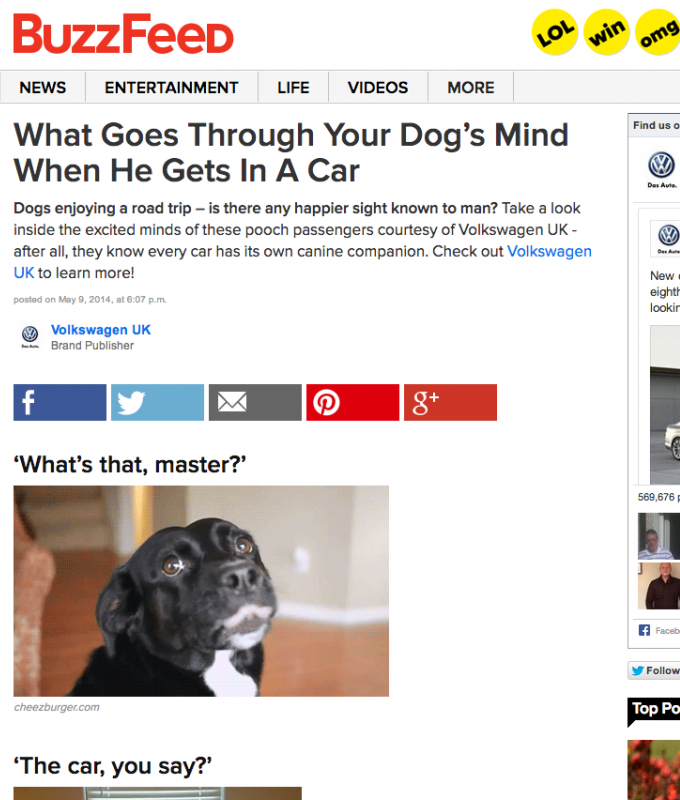The Value Of Buzzfeed and What We Can Learn From It
Since Buzzfeed was founded in 2006 by Jonah Peretti, it’s grown to become one of the most visited websites on the internet. Initially launched as a social news and entertainment website, Buzzfeed has developed into an international global media company that reports on news, current affairs and much more. Not only that, it’s an absolutely superb place to procrastinate.
Posts on Buzzfeed are often complete nonsense, however they do encourage sharing across a visitor’s social channels. Not a day goes by where you don’t see a Buzzfeed article on your Facebook Newsfeed or a link to some ridiculous story on Twitter about why kittens can cheer up your turgid Monday (probably true if I’m being honest).
How can a website that posts content such as “32 Regrettable ’90s Guys Fashion Trends” and “23 Problems Only People With Freckles Will Understand” become so incredibly influential? What can we learn from Buzzfeed and it’s unique way of showcasing content?
Rumour has it that earlier this year, the Walt Disney Co. were sniffing around and put together an offer to purchase Buzzfeed for upwards of $1billion before it fell apart. Why is it so valuable and why does everybody want a piece of it? Check out a few of our thoughts:
The content is different.
We’ve all read a million blogs, but Buzzfeed does things a little bit differently. Using powerful imagery, embedded social media, memes, and GIFs amongst a whole range of other content, it altogether feels like something totally alternative. Buzzfeed has given brands the confidence to branch out and become publishers with ease.
Take Volkswagen for example, they’ve embraced Buzzfeed with open arms creating content such as “12 Stages Of Your Relationship With Your Car” and “14 Things Dads Get Abnormally Excited About”. Whilst this may not be too relevant to what Volkswagen actually sell, they’ve received a vast amount of shares and likes, increasing their authority and trust with users. They’ve moved beyond using generic advertising drivel, and are sharing interesting and engaging content intertwined with their overall marketing strategy.

Regular, engaging posts help to establish authority and build reputation amongst readers. Brands are becoming inspired by what’s being created on Buzzfeed and they’re using its influence throughout their own channels and digital strategies.
Know your audience.
Buzzfeed has shown us that knowing your audience is incredibly vital. The website pretty much relies on modern and popular culture to engage with audiences and generate with traffic. If you’re marketing business to consumer, Buzzfeed has become the perfect place for inspiration into how to create content in the future.
Try out a few different styles of posts and references to see what works well for you. This is something that’ll easily transfer over to your own blog, website or social media networks. Remember, creating something content that’s sharable is vital. According to Buzzfeed’s own data, Facebook delivers 3.5 times more page views to their website over Google, suggesting that shareable content is a necessity. It’s important to note that this should be used as part of a wider SEO strategy, but do consider the power of social media.
GIFs are king.
Yep, it’s true.
Many of our digital marketing cohorts have been banging on about how images are an essential factor throughout content to increase overall engagement. Buzzfeed however, have raised the game and taken it to a new level.
By embedding GIFs into the majority of posts, it instantly grabs attention and makes the content shareable. Most GIFs feature short clips from movies or popular culture to emphasise points in a comical and inventive way.



Readers have become tired of reading through walls of text, and the probability of it getting shared is low. GIFs provide the perfect opportunity to break up the content, show a bit of personality and add a touch of humour.
Sack off the adverts.
Another thing that Buzzfeed do well is to limit the amount of visible advertising on the website, creating a more enjoyable user experience. Sites that are littered with advertising can be a distraction and result in visitors leaving. As an alternative, Buzzfeed are now using sponsored posts as way to generate income, proving popular with users and brands. If you’re using ads, why not think about following this trend?
Love it or hate it, Buzzfeed is impacting modern digital marketing more than ever. Only time will tell as to where it will go next. What are your thoughts on Buzzfeed? Drop us a line, we’d love to hear from you.